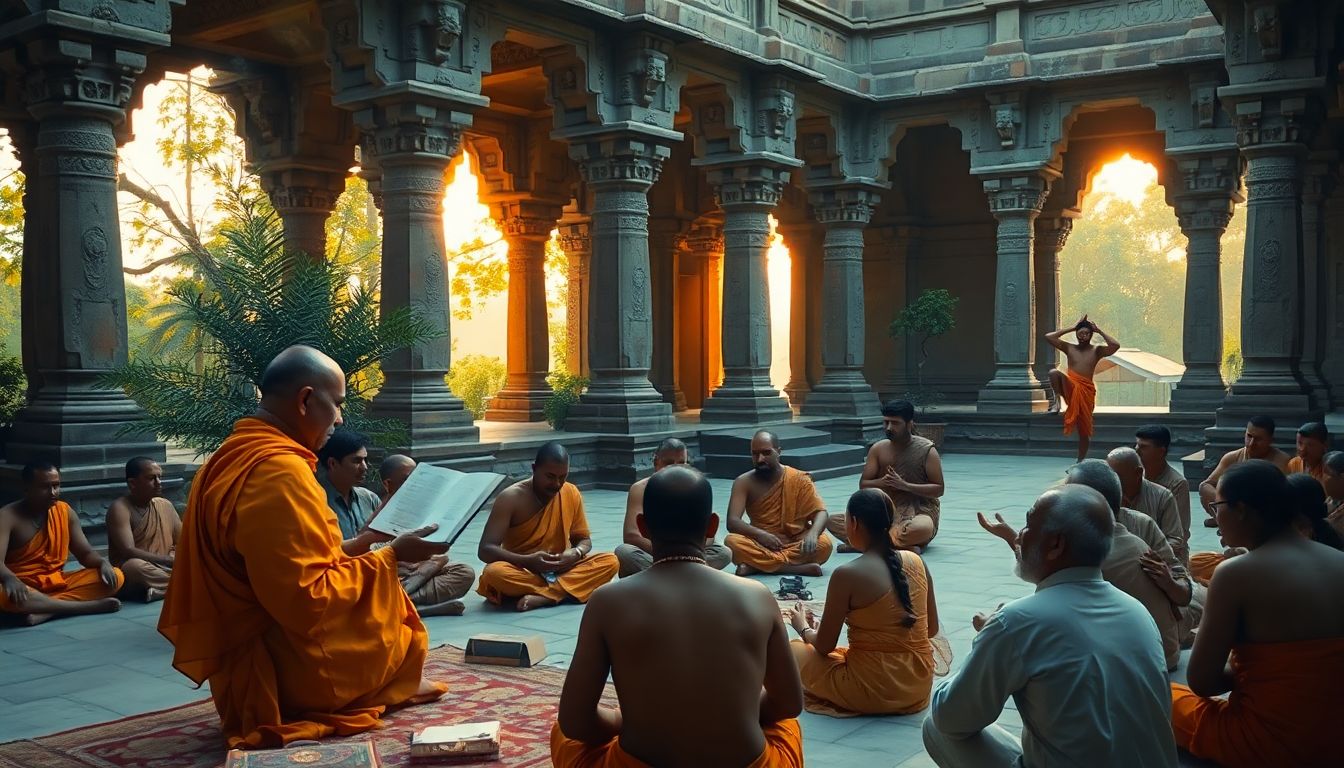Jnana Krama Sanyasa : A Journey of Knowledge and Action
Imagine blending the energy of action with the calm of understanding. That’s what Jnana Karma Sanyasa Yoga offers. It’s a path from the Bhagavad Gita that shows how doing your duties and gaining inner wisdom can go hand in hand. This idea isn’t just for monks or spiritual leaders. It’s a blueprint for anyone wanting a balanced life filled with purpose and peace. When we connect action with knowledge, we get a stronger mindset and a clearer sense of who we truly are. Many thinkers and spiritual travelers have found depth and clarity in this approach, making it relevant even today


Action and Knowledge: Exploring Jnana Karma Sanyasa Yoga for Spiritual and Practical Wisdom
Introduction
Imagine blending the energy of action with the calm of understanding. That’s what Jnana Karma Sanyasa Yoga offers. It’s a path from the Bhagavad Gita that shows how doing your duties and gaining inner wisdom can go hand in hand. This idea isn’t just for monks or spiritual leaders. It’s a blueprint for anyone wanting a balanced life filled with purpose and peace. When we connect action with knowledge, we get a stronger mindset and a clearer sense of who we truly are. Many thinkers and spiritual travelers have found depth and clarity in this approach, making it relevant even today.
Understanding Jnana Karma Sanyasa Yoga: The Core Philosophy
Definition and Origin
Breaking down the words helps us understand the essence. "Jnana" means knowledge—specifically, understanding your inner self. "Karma" signifies action—what you do daily. "Sanyasa" refers to renunciation or detachment—doing actions without selfish ties. In the Bhagavad Gita, especially Chapter 5, Lord Krishna explains how these paths are connected. He teaches that real spiritual growth involves merging self-awareness with responsible action. This approach isn't about choosing between action and wisdom; it’s about finding harmony between them.
The Philosophical Foundations
At its root, Jnana Karma Sanyasa Yoga leans on Vedanta—particularly the idea of non-dualism, or Advaita. It states that everything is one divine reality. When we realize our true nature (Atman), we see beyond the surface and understand that we are part of the universe. This knowledge brings freedom. Yet, it also stresses that performing duty with proper awareness is equally vital. The verses from the Gita emphasize that true yoga involves both heart and mind working together for liberation.
Significance in Spiritual Evolution
The goal? Moksha, or ultimate freedom. This yoga offers a path that combines the best of both worlds: doing your duties without attachment while understanding the deeper truths of existence. Unlike pure jnana yoga, which can seem abstract, or karma yoga, which might appear superficial, this synthesis keeps us grounded and focused. For everyday life, it means acting responsibly and seeking self-awareness simultaneously—turning daily chores into spiritual practice.
Core Principles of Action (Karma) in Jnana Karma Sanyasa Yoga
Performing Selfless Action
Karma yoga involves doing your work without expecting rewards. Think of a gardener planting seeds with no concern for the harvest. This mindset shifts your focus from personal gain to service. Many spiritual leaders, like Mahatma Gandhi, practiced karma yoga by acting selflessly for the greater good. For you, it could mean helping others or performing your job with honesty. Action Tip: Be mindful during daily tasks—notice your motives and practice letting go of the need for recognition.
Detachment and Equanimity
How do we stay calm even when things go wrong? Jnana Karma Sanyasa Yoga teaches us to stay detached from results. When success or failure no longer shake us, we develop resilience. This isn’t about ignoring emotions but observing them without clinging. Psychologists call this emotional resilience—staying steady in any situation. Practice mental journaling. Write down your feelings and look at them objectively. This builds mental strength and keeps you centered.
Duty and Responsibility
Our lives are filled with responsibilities. The key is performing duties without selfish motives. The Bhagavad Gita reminds us—to see duty as a spiritual practice—not just a task. Whether it is caring for family, work, or community, do it wholeheartedly but without attachment to gain. This attitude releases stress and introduces joy into routine activities. It transforms work from a burden into a form of worship.
Knowledge (Jnana) as a Path to Wisdom
Self-Realization and Inner Knowledge
Jnana means knowing your true self. It’s more than just intellectual understanding; it’s an inner awareness of being whole. Self-inquiry, or asking yourself "Who am I?" helps peel back layers of false identities like ego or desires. Swami Vivekananda often said that self-knowledge is the highest goal. When you realize you are not your mind, body, or possessions but pure consciousness, freedom begins.
Discrimination and Renunciation
Viveka, or discernment, helps to distinguish what’s real from what’s transient. Vairagya, or detachment, frees us from unhealthy attachments. Studying spiritual texts, meditating, and reflection build this clarity. Daily self-reflection pushes you closer to understanding your true nature. Action Tip: Spend a few minutes each day contemplating your purpose and values to strengthen this inner wisdom.
Overcoming Ignorance
Ignorance clouds our understanding. It leads to mental impurities, wrong beliefs, and suffering. The journey toward enlightenment involves shedding these mental blocks. Classical texts like the Upanishads highlight the importance of self-awareness. Ramana Maharshi’s path of self-inquiry shows how persistent questioning clears confusion. Learning to see beyond appearances leads to inner peace and clarity.
The Integration of Action and Knowledge in Practice
The Path of Balanced Living
Living this yoga means doing everyday chores while remaining aware. It’s about aligning your actions with your inner values. When you perform tasks with mindful awareness and understanding, life becomes a spiritual journey. Practical tip: Set an intention each morning—to act with kindness, honesty, or patience. Let that purpose guide your day.
Role Models and Historical Figures
Leaders like Swami Sivananda and Ramakrishna Paramahamsa show us how to blend action with knowledge. They motivated many to serve others while deepening their understanding of the divine. Their lives teach us that spiritual practice isn’t separate from daily life but woven into it.
Modern Applications
Today, Jnana Karma Sanyasa Yoga remains relevant in careers, relationships, and social work. Ethical decisions driven by awareness create healthier workplaces and communities. Many organizations are adopting mindfulness and responsible action as part of their culture, proving that this ancient wisdom still shapes modern life.
Challenges and Misconceptions
Common Misunderstandings
Some believe this yoga asks to give up work or social life. Not true. It teaches performing duties with a spirit of detachment. Others think renunciation means avoiding action altogether. Instead, it’s about doing your tasks without ego or selfish goals. Balance is the key.
Overcoming Practical Obstacles
Maintaining harmony between action and knowledge can be tough. Distractions and habits may pull us away. Regular guidance and self-assessment help stay on track. Remember: progress involves patience and persistence.
Conclusion
Jnana Karma Sanyasa Yoga shows us how responsible action aligned with deep understanding leads to a fulfilling life. It offers a practical way to grow spiritually while living our duties fully. By blending awareness with service, we unlock mental clarity and inner peace. Start small—bring mindfulness into daily tasks and seek understanding through self-inquiry. This integrated approach can truly transform your journey, leading to liberation and truth.
Embrace the balance of action and knowledge today—your path to wisdom begins with a single step.



 VARSHITHA
VARSHITHA